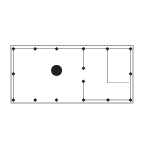The armature of this urban strategy is a rigorous but adaptive structural diagram, based on a modified 9-square grid, which is populated by six unit types on residential floors but which also supports retail, resident amenities and parking. Units occupy between 4 and 9 12.5’x12.5’ modules and are aggregated to produce different typical residential plans. An absence of units produces an open office floor plate while aggregations of 8 or 10 units produce three residential plans which are acted upon to produce reciprocity, and modulate density.
These subtractions have volumetric and planimetric effects with urban, and local implications. By urban I mean having to do with the reading of the site as a whole, perhaps from a passing car on I-10 or by a pedestrian from afar, and by local I mean, the perception of spatial effects up close, perhaps from within a moment of reciprocity.
Unit subtractions occur in 1, 2 or 3 story varieties. Because subtraction can respond to market demand, different proportions of unit types produce more or less articulate buildings. This effect contributes to an urban reading of the project as something that flickers between variety and repetition. The planimetric effect of the subtraction is to delineate implied boundaries inhabited by programmatic elements which are shared by adjacent buildings. I used a catalog as a tool to understand how reciprocities of different sizes, and in different numbers and orientations work in relation to one another. Ultimately, this catalog was important in order to understand how an organization of reciprocities scales from a single building to a whole site and how the reciprocity can be instrumentalized with phasing to produce moments of anticipation.
Copyright © 2018 Evio Isaac
Emergent
reciprocity
Project Info
Program: Masterplan
Location: Houston, TX
Year: 2016
Houston is rich with the materials of a vibrant urbanism. Swatches of consonant and dissonant abstract pattern found downtown are perhaps a suggestion of the expressive fabric Houston is capable of, and the root of the ambition of this study. Despite the fecundity of Houston’s abstraction, formal ambivalence and programmatic ambiguity, have resulted in a menagerie of object buildings that, despite literal adjacency, struggle to relate or generate a meaningful public realm. Emergent Reciprocity seeks to instrumentalize the physical and abstract conditions and materials that exist in Houston to create moments of cognizance and urban confluence. Reciprocity is a product of formal infection. Small swab tests and subsequent formal studies begin to assess the potential of an infectious urbanism that populates adjacent buildings with common form and fenestration. More than skin deep, the resulting reciprocities begin to delineate spatial boundaries affiliated with multiple buildings. Within the framework of a masterplan, the ambition of mutual formal inflections is that they become programmatic boundaries that support coalitions of symbiotic programmatic elements in a sympathetic public realm.
Studio Critic: Jesus Vassallo
